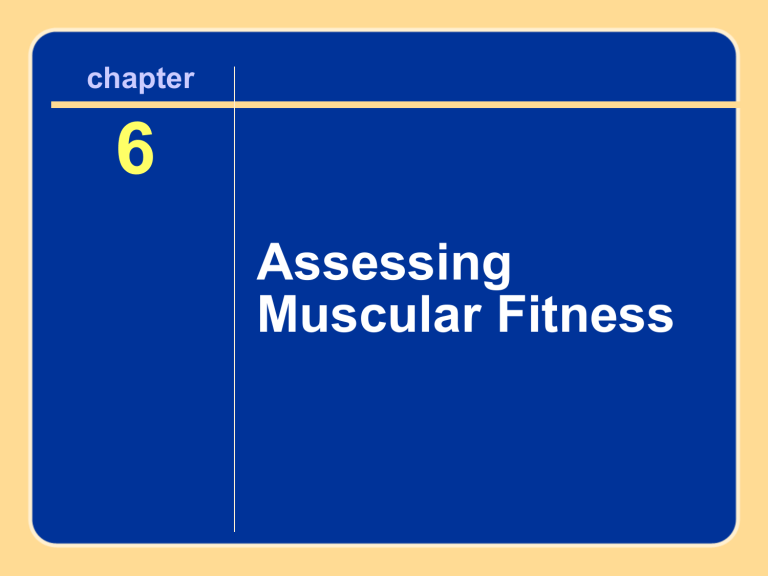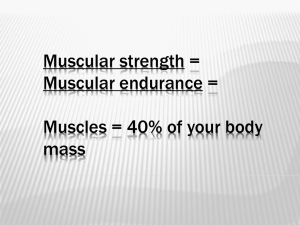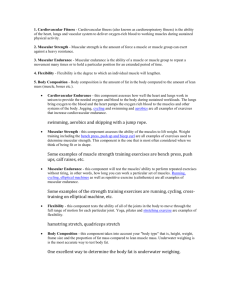Assessing Strength and Endurance

66
Assessing
Muscular Fitness
Author name here for Edited books
Objectives
• Identify methods for assessing muscular strength and endurance
• Understand how type of muscle contraction affects force production
• Differentiate between advantages and limitations of free weights as compared to machine weights for assessment
• Learn sources of error in the assessment of muscular fitness and how to control them
• Learn procedures for conducting 1-RM tests
• Appreciate challenges of conducting muscular fitness assessments for the elderly and children
• Identify methods for assessing functional strength of elderly adults
Muscular Strength
• Definition: The ability of a muscle group to develop maximal contractile force against a resistance in a single contraction.
• Force developed during muscular contraction is determined by velocity of the contraction.
• Maximal force is determined at a velocity of zero.
Muscular Endurance
• Definition: The ability of a muscle group to exert submaximal force for extended time periods.
• Similar to muscular strength, it can be assessed for static (isometric) or dynamic contractions.
Types of Contractions
• Static (isometric): no visible change in joint angle
• Dynamic: visible change in joint angle
• Types of dynamic contractions
– Concentric
– Eccentric
– Isokinetic
Concentric Contraction
• Force exerted by muscle or muscle group exceeds external resistance or load
• Joint angle decreases
• Muscle shortens
Eccentric Contraction
• Joint angle increases
• Muscle lengthens while contracting
• Serves as a braking mechanism to decelerate body segment movement
Isokinetic Contraction
• Maximal contraction of muscle or muscle group at a constant velocity throughout entire range of motion
(ROM)
• Specialized machines control velocity of contraction and adjust external resistance to match the force produced at degree in the ROM
• Resistance is variable, velocity is constant
Figure 6.2
Assessing Strength and Endurance
• Isometric muscle testing: strength measured as the maximum force exerted in a single contraction against an immovable resistance
• MVIC: maximal voluntary isometric contraction
• Devices used to assess static strength and endurance:
– Dynamometers
– Cable tensiometers
– Strain gauges
– Load cells
(continued)
Assessing Strength and Endurance
(continued)
• Dynamic Muscle Testing: strength measured as the maximum force exerted in a single contraction against a movable resistance
• Devices used to assess dynamic strength and endurance:
– Free weights
– Constant-resistance machines
– Variable-resistance machines
– Isokinetic machines
(continued)
Assessing Strength and Endurance
(continued)
• Hand grip dynamometry for strength:
– Adjust hand grip to accommodate client’s hand.
– Set dial to zero.
– Stand upright and grasp dynamometer.
– Arm position varies between protocol selected.
– Client squeezes hand grip quickly and as tightly as possible and then releases the pressure.
– Extraneous body motion is kept to a minimum.
– Do 3 trials for each hand; 1-minute rest between trials.
– Select best trial for each hand.
Back and Leg Dynamometry
• Both use same dynamometer; score in kg
• For leg assessment:
– Start with knees flexed to 130 o to 140 o.
– Use pronated grip with bar across thighs.
– Extend knees but do not engage back muscles to pull bar straight up .
• For back assessment:
– Fully extend knees and keep head and back erect.
– Use over-under grip with the bar across the thighs.
– Pull bar straight up by rolling shoulders without bending backward.
Dynamometry Normative Values
• Can use dynamometric scores to determine static muscular strength:
– Add best strength score for right hand, left hand, legs, and back.
– Be sure to convert values to lb.
• Can use total dynamometric score to compute relative static muscular strength score (divide total score by body weight and multiply by 100).
Table 6.2
Table 6.3
Isometric Strength Assessment
• Use cable tensiometers or strain gauges.
• Follow standardized procedures closely.
• Select proper tensiometer based on anticipated strength score (above or below 100 lb).
• Isometric assessments specific for single joint angle.
• Testing of multiple muscle groups is recommended for overall strength score.
• Digital, handheld dynamometers are now available.
• Detailed procedures for digital dynamometry are in appendix C of textbook.
Figure 6.4a
Figure 6.4b
Dynamic Strength and Endurance
• Constant-resistance machines or free weights are best.
• However, each only assesses maximal strength of weakest point in joint ROM.
• Why? Mechanical and physiological advantage changes throughout ROM, but resistance doesn’t.
• Variable-resistance machines (VRM) were created to address this.
• Load changes throughout ROM with VRMs, so it is difficult to assess maximal strength.
• Not recommended for strength assessment, but good for resistance training programs.
Free weights Versus Constant-
Resistance Machines
Free weights
• Increase neuromuscular
Constant-resistance machines
• Increase neuromuscular coordination coordination
• Allow full ROM • ROM limited by machine
• Spotter may be required • No spotter required
• Weight increments may be limited
• Machines may not accommodate all body types
Free-Motion Machines
• Eliminate many challenges of free weights and constant-resistance machines
• Allow movement in multiple planes
• Can allow both constant- and variable-resistance exercise
• Have many adjustable compartments
• Must simulate starting and ending body position of validated muscular tests in order to use those normative values
• Note settings during baseline assessment testing; use them for follow-up assessment settings.
Dynamic Strength Testing
• One-repetition maximum (1RM): maximum weight that can be lifted for one complete repetition of the movement
• Involves trial and error in setting weights
• Has been applied to all age groups, but use standardized technique to keep all clients safe.
• Spotting for your client is a must.
• 1RM bench press and leg press are good for assessing upper body and lower body strength.
• Compute relative strength (maximal lift/body mass) and use normative values.
Dynamic Endurance Testing
• Perform multiple repetitions with weight that is set submaximal load (%1RM) or set %body mass.
• Individual should be able to perform 12 to 15 reps of each exercise with weight that is 70% of 1RM.
(continued)
Dynamic Endurance Testing
(continued)
• Other options
– YMCA bench press test: gender-specific resistance at set cadence
– Seven-item multiple repetition battery: maximum of
15 reps at set % of client’s body mass; add the number of reps completed over the seven items; use sum for overall categorization of dynamic muscular endurance score
Isokinetic Assessment
• Assesses strength, endurance, and power.
• Machine generates resistance equivalent to client’s muscular force generation (accommodating resistance).
• Limb moves at constant, preselected velocity.
• Can evaluate peak torque, total work, and total power for each muscle group tested.
Omnikinetic Assessment
• Accommodating resistance machine that adjusts to both force and velocity generated by client (variable force, variable velocity)
• No preset velocity
• Force and velocity adjust downward as client begins to fatigue (self-accommodating)
• Assesses isokinetic strength and endurance of both fast-twitch and slow-twitch motor units in the muscle group.
Field Test Assessments
• Dynamic strength tests: Add additional weight to client and have them perform the desired movement as a 1RM.
• Dynamic endurance tests: maximum number of reps performed for select calisthenic exercises
– Pull-ups
– Push-ups
– Trunk curls
Sources of Error
• Possible reasons for measurement errors in fitness testing:
– Client factors
– Equipment
– Technician skill
– Environment
Additional Concepts
• Can estimate 1RM from submaximal tests
• Look for muscle balance: upper versus lower body; agonist versus antagonist; left versus right side
• Best to express client strength results in relative terms
Working With Older Clients
• Muscular strength and endurance are important for maintaining functional independence and activities of daily living (ADLs).
• You can use 1RM assessments with this age group.
• You may prefer to estimate 1RM from submaximal loads:
– Brzycki (1993) equation and Wathen (1994) equation are recommended
Functional Testing for Older Clients
• Rikli and Jones (2001) battery assesses physical capacity and functional fitness through
2 tests:
– 30-second chair stand
– 30-second biceps curls
• These tests have functional application for older clients’ ADLs.
• Be sure to follow standardized technique and follow known safety precautions.
Working With Children
• Children can safely perform 1RM trials.
– Must be closely supervised
– Best results obtained using child-sized equipment
• No support for contention of premature closure of epiphyseal plates due to strength training
• Follow standard guidelines when testing 1RM:
– Be sure to allow for familiarization trial(s)
– Focus on proper lifting and breathing techniques




